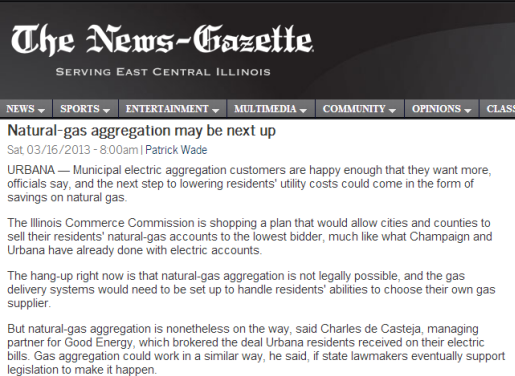Natural-Gas Aggregation May Be Next Up
 The Committee for Municipal Electricity Choice | Posted on
The Committee for Municipal Electricity Choice | Posted on  Thursday, March 21, 2013 at 01:07PM
Thursday, March 21, 2013 at 01:07PM Municipal electric aggregation customers have seen real savings since aggregation early last year and the prospect of additional energy savings through natural gas aggregation has people excited. The counties of Champaign and Urbana were among the first to approve referendums allowing electric aggregation. These referendums allowed authorities to contract Good Energy, an electric aggregation consulting firm, to negotiate new rates on their electricity service.
And with the success of electric aggregation, there is a strong push by the Illinois Commerce Commission, with the support of Good Energy, to legalize natural-gas aggregation. The major issue holding gas aggregation up is the fact that it is not currently legal. But, “there’s a groundswell of demand for it,” or so says Charles de Casteja, the managing partner for Good Energy. Given the previous successes Illinois has seen with energy aggregation and the sizeable demand for energy aggregation growth, it seems likely a solution will soon be worked out.
Energy aggregation has lead to tangible savings for the residents of Urbana. They secured a guaranteed rate of 4.05 cents per kilowatt hour through the aggregation initiative. The current rate per kilowatt hour for electricity through Ameren, on the other hand, is 5.45 cents. Mike Monson, the chief of staff to Urbana Mayor Laurel Prussing, summed up the sentiment of residents, “We’ve saved a lot of money. The residents have saved a lot of money.”
Hundreds of other municipalities have voted on similar measures since the beginning of last year. After a vote last November, a second wave of aggregation was negotiated, and after the April ballots, a third wave is scheduled. Given the results of electric aggregation, it is not surprising de Casteja said gas aggregation is a program he believes state lawmakers would be eager to support.
For more information on municipal aggregation, click here. For the full article, see below.

